Organizations worldwide are experiencing a seismic shift as AI impact on business accelerates. From cost efficiencies to groundbreaking innovations, companies that fail to integrate AI risk falling behind, and ultimately being replaced by more agile, data-driven competitors. Artificial intelligence is not just another technology trend; it represents a fundamental change in how value is created and delivered. As AI capabilities evolve, businesses gain unprecedented insights, automate complex tasks, and unlock new revenue streams. Those who hesitate to adapt confront dwindling market share, eroded profitability, and obsolescence.

How Do AI Business Benefits Translate into Competitive Advantage?
The transformative potential of AI manifests across multiple dimensions:
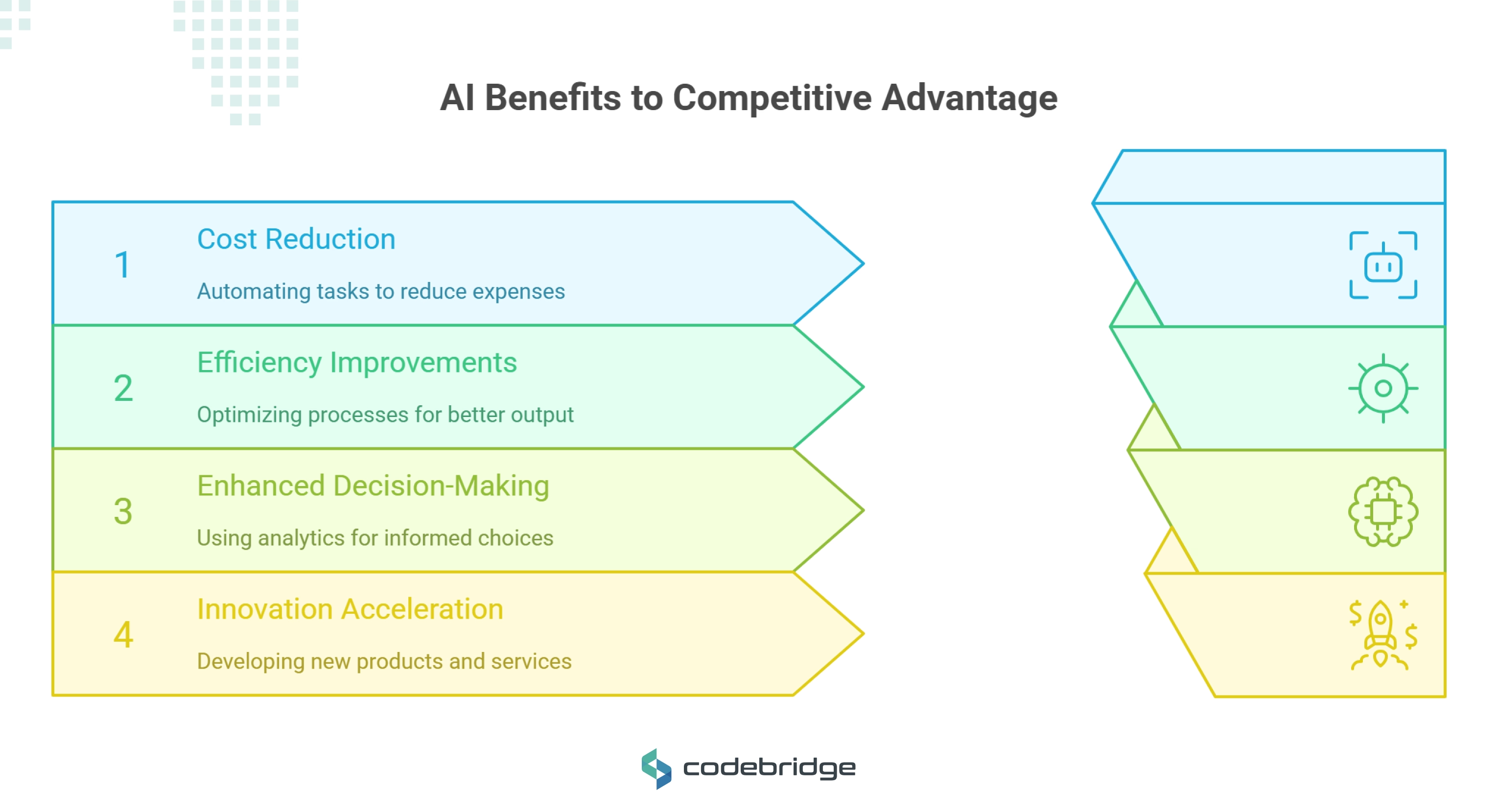
- Cost Reduction Through Automation
By automating routine and repetitive tasks, such as invoice processing, payroll reconciliation, and customer support triage, organizations can reduce labor expenses by up to 30%. Robotic process automation (RPA) bots operate 24/7 without errors, enabling redeployment of human talent to strategic, creative, or customer-facing roles. The cumulative savings from even a handful of high-volume processes can offset AI implementation costs within months.
- Efficiency Improvements and Process Optimization
Machine learning algorithms excel at identifying inefficiencies and recommending optimizations. In supply chains, predictive analytics forecast demand fluctuations, enabling just-in-time inventory management that cuts carrying costs by 20–25%. In manufacturing, computer-vision systems inspect products with near-perfect accuracy, reducing defect rates by 50%. These gains translate directly into faster time-to-market and higher customer satisfaction.
- Enhanced Decision-Making with Advanced Analytics
Traditional business intelligence tools report historical performance, but AI-driven analytics deliver prescriptive insights and real-time forecasts. Natural language processing (NLP) models can parse customer feedback, competitor news, and market reports, surfacing hidden risks and emerging opportunities within minutes. Decision-makers armed with these insights outmaneuver rivals by responding proactively to shifting conditions.
- Innovation Acceleration and New Revenue Streams
Generative AI models, such as large language models and deep-learning image generators, accelerate product design, content creation, and software development. These tools can prototype marketing copy, draft technical documentation, or generate personalized product recommendations at scale. Innovators who integrate generative AI unlock entirely new services, such as AI-powered chatbots, virtual assistants, and adaptive learning platforms, that generate additional revenue.
Collectively, these AI business benefits forge a sustainable AI competitive advantage, positioning adopters to outperform peers in speed, quality, and innovation.
What Are the Key Steps in an AI Implementation Business Framework?
A structured approach ensures successful AI initiatives. The CODER model provides a comprehensive AI implementation business framework:
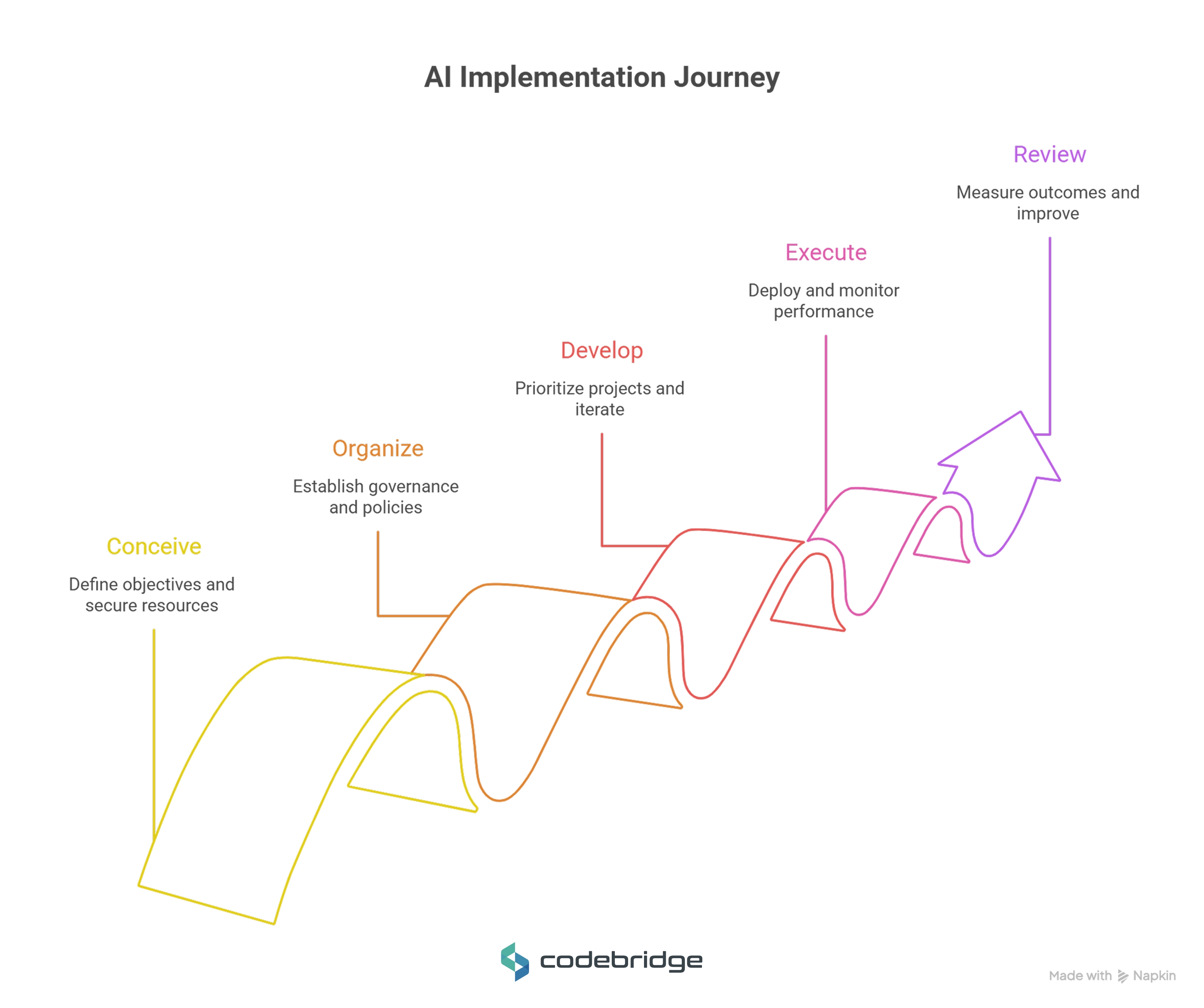
- Conceive
- Define clear objectives that align with strategic goals (e.g., increasing revenue by 10%, reducing customer churn by 5%).
- Conduct a data audit to assess availability, quality, and compliance constraints.
- Secure executive sponsorship and allocate a dedicated budget.
- Organize
- Establish a cross-functional AI Center of Excellence (CoE) with representatives from IT, data science, legal, and business units.
- Develop governance structures to oversee model risk management, ethical considerations, and data privacy.
- Create documented policies for data usage, model development, and change management.
- Develop
- Prioritize pilot projects based on feasibility and expected ROI.
- Leverage open-source frameworks (e.g., TensorFlow, PyTorch) or partner with AI solution vendors.
- Iterate rapidly using agile sprints, incorporating stakeholder feedback at each stage.
- Execute
- Deploy successful pilots into production environments, integrating with existing systems via APIs or microservices.
- Monitor model performance in real time, implementing alerting mechanisms for drift and anomalies.
- Provide user training and change-management support to drive adoption.
- Review
- Measure outcomes against predefined KPIs, such as cost savings, revenue lift, or customer satisfaction improvements.
- Conduct post-implementation audits to identify lessons learned and process improvements.
- Institutionalize a continuous improvement cycle, updating models and processes as new data and techniques emerge.
Following these phases mitigates risk, fosters stakeholder alignment, and accelerates value realization, ensuring AI becomes a scalable, sustainable capability.
How Can Executives Develop an AI Adoption Strategy That Works?
Crafting a robust AI adoption strategy involves more than technology selection; it requires a holistic organizational shift:
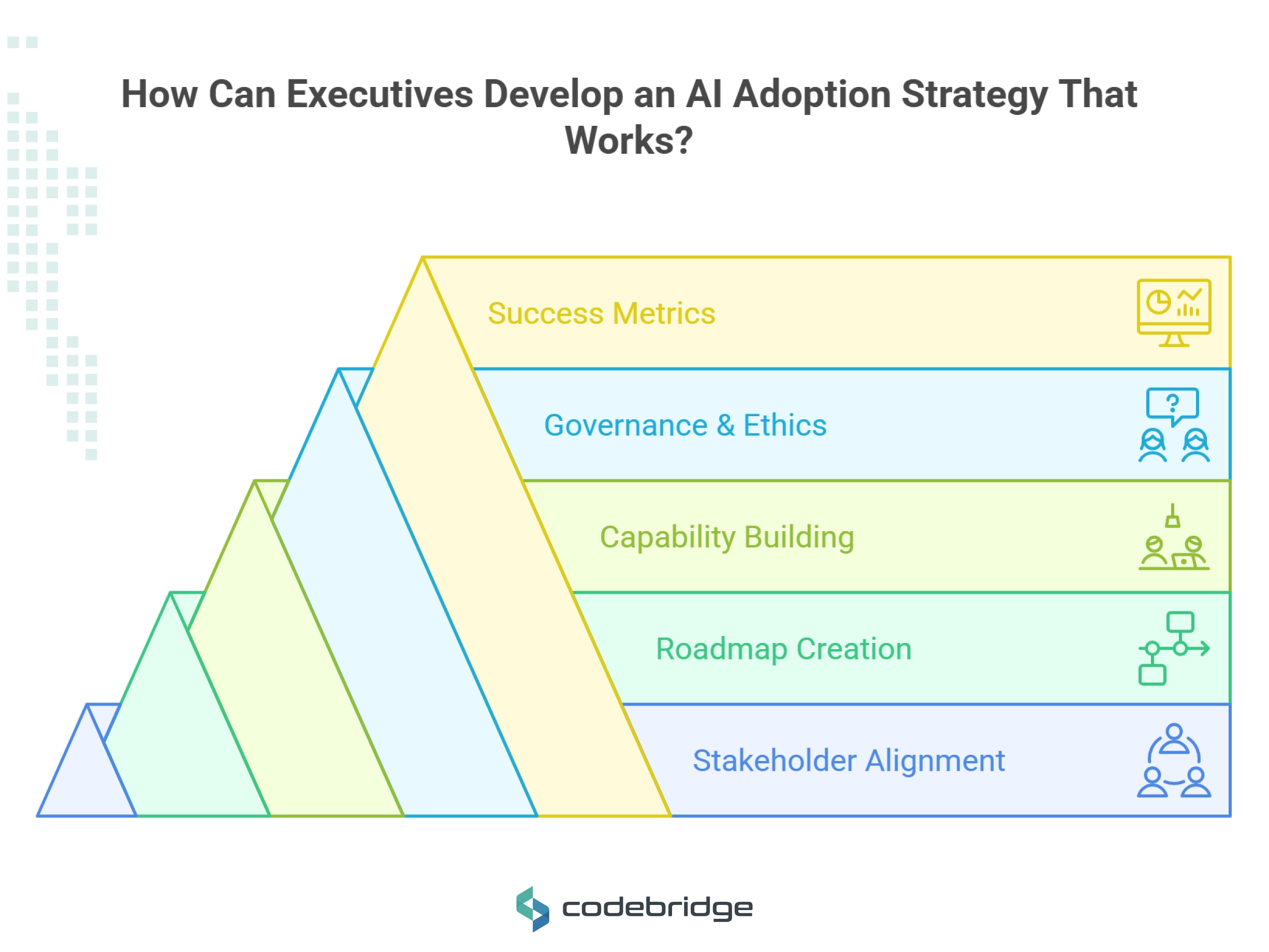
- Stakeholder Alignment
Begin by engaging C-suite leaders to define a clear vision and secure funding. Workshops with IT, legal, and frontline staff help surface concerns, identify high-impact use cases, and foster shared ownership.
- Roadmap Creation
Develop a phased roadmap that balances quick wins, such as automating simple data-entry tasks, with strategic, long-term initiatives like building proprietary AI-driven products. Assign owners, timelines, and success metrics to each milestone.
- Capability Building
Invest in modern data infrastructure, such as cloud data lakes and real-time streaming platforms, to ensure scalable, reliable data pipelines. Simultaneously, address talent gaps by recruiting data scientists, partnering with academic institutions for internships, and launching internal upskilling programs.
- Governance & Ethics
Create an AI ethics council to define guidelines around data privacy, algorithmic transparency, and fairness. Ensure models are auditable, bias is regularly tested, and decision-making processes are explainable to both internal and external stakeholders.
- Success Metrics
Define quantitative KPIs, like percentage reduction in processing time, percentage improvement in forecast accuracy, or incremental revenue attributed to AI-driven products. Use dashboards to track these metrics and communicate progress to the broader organization.
By embedding AI into the corporate strategy rather than treating it as a siloed “tech project” leaders can transform AI from an experimental pilot into a core driver of business growth.

What Metrics Define AI ROI Business and Ensure Measurable Success?
Quantifying AI ROI business is critical to secure ongoing investment and drive continuous improvement. Key measurement approaches include:
- Cost-Benefit Analysis
Compare total cost of ownership (TCO), including infrastructure, software licenses, talent acquisition, and change-management expenses, against documented savings in labor, error reduction, and operational efficiencies. For example, a financial services firm implementing an AI-powered underwriting system reported a 40% decrease in manual review hours, translating into $2 million in annual savings.
- KPI Tracking
Common KPIs include:
- Process Cycle Time Reduction: Percent decrease in end-to-end process duration (e.g., order-to-cash).
- Accuracy Improvements: Reduction in error rates or false positives (e.g., fraud detection precision).
- Customer Satisfaction: Net Promoter Score (NPS) lift attributable to AI-driven personalization.
- Revenue Uplift: Incremental sales generated by AI-recommended cross-sell and upsell offers.
- Continuous Optimization
Employ A/B testing frameworks to compare AI-driven workflows against traditional methods. Real-time dashboards provide visibility into model drift, enabling prompt retraining and parameter tuning. This iterative cycle ensures sustained performance improvements and adapts AI solutions to evolving business needs.
By linking AI initiatives to concrete business outcomes, organizations can demonstrate value transparently and justify further investment.
In Which Industries Does AI Healthcare Business Create the Biggest Impact?
According to McKinsey’s State of AI 2025 report, 72% of organizations have adopted at least one AI capability in their workflows, up from 55% in 2022.
Yet only 17% report scaling AI successfully across multiple business units, revealing a maturity gap between experimentation and enterprise-wide transformation.
AI’s industry-specific applications underscore its versatility and transformative power:
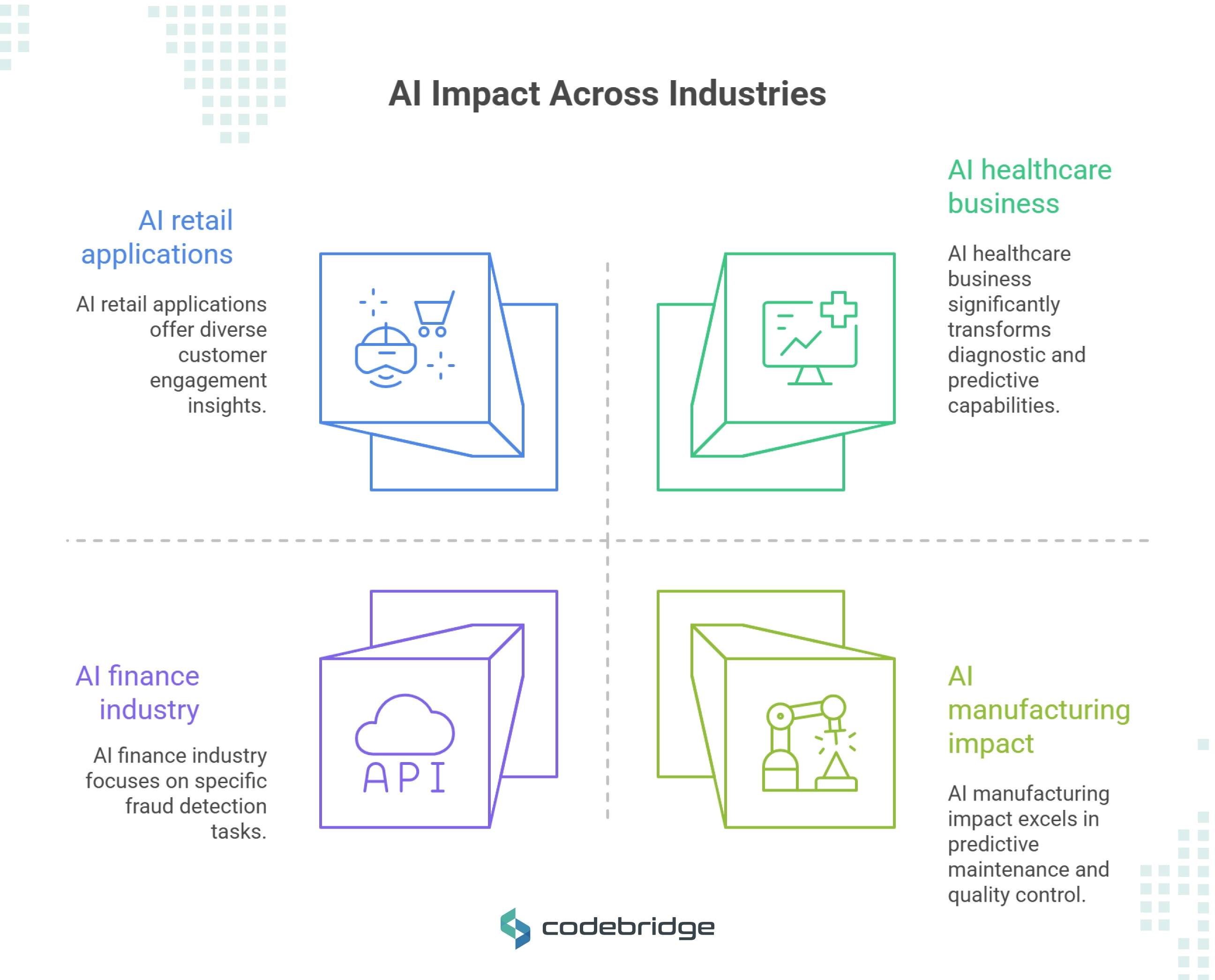
- AI healthcare business
Diagnostic imaging systems powered by convolutional neural networks (CNNs) can detect abnormalities, such as tumors or fractures, with accuracy rates exceeding 95%, cutting radiology backlogs in half. Predictive analytics models forecast patient deterioration, enabling early interventions that reduce ICU stays by 20%.
- AI manufacturing impact
Predictive maintenance solutions analyze sensor data from equipment, such as vibration, temperature, and acoustic signatures, to predict failures days before they occur. This capability reduces unplanned downtime by 30–40% and extends asset lifespans. Automated quality-inspection cameras identify defects invisible to the human eye, achieving defect-detection rates above 99%.
- AI retail applications
Eye-tracking and NLP analytics provide deep insights into customer engagement with physical and digital storefronts. AI-driven demand-forecasting models improve inventory accuracy, cutting stockouts by 35% and markdowns by 25%. Personalized recommendation engines boost average order values by 10–15% by serving hyper-relevant product suggestions.
- AI finance industry
Real-time fraud-detection algorithms leverage machine learning to identify anomalous transactions with sub-second latency, preventing losses and bolstering trust. Robo-advisors automate portfolio management, using reinforcement learning to adapt to volatile market conditions, and have attracted over $400 billion in assets under management worldwide.
By tailoring AI solutions to sector-specific challenges and regulatory requirements, businesses unlock deeper value and cement their positions as industry leaders.

What Are the Top AI Integration Challenges, and How Can They Be Overcome?
Despite clear benefits, implementing AI at scale presents hurdles that require strategic attention:
- Data Quality & Silos
Challenge: Inconsistent data formats, missing values, and fragmented data repositories impede model training and accuracy.
Solution: Establish a unified data lakehouse architecture, implement data-cleaning pipelines, and adopt master data management (MDM) practices. Regular data audits and “data stewards” help maintain integrity.
- Change Management & Cultural Resistance
Challenge: Employees may mistrust AI or fear job displacement, leading to low adoption and suboptimal performance.
Solution: Communicate AI’s role as a collaborator, not a replacement. Offer targeted reskilling programs, involve end users in pilot testing, and publicize early wins to build momentum.
- Talent Gaps & Skill Shortages
Challenge: Competition for data scientists and ML engineers is fierce, with global demand outpacing supply by 60%.
Solution: Partner with universities for research collaborations, establish apprenticeship programs, and leverage AI-augmented development tools to boost productivity of existing teams.
- Legacy System Compatibility
Challenge: Monolithic applications and outdated databases lack the flexibility to support real-time AI workloads.
Solution: Adopt a hybrid integration strategy: containerize AI services with Docker and Kubernetes, expose functionality via RESTful APIs, and gradually migrate monolithic components to microservices.
- Ethical and Regulatory Constraints
Challenge: Evolving regulations, such as GDPR, HIPAA, and the EU’s proposed AI Act, impose stringent requirements on data usage, transparency, and accountability.
Solution: Develop an AI ethics and compliance framework, conduct algorithmic impact assessments, and integrate privacy-by-design principles into data pipelines.
By proactively addressing these challenges with targeted strategies, organizations transform barriers into competitive differentiators that underpin robust, scalable AI deployments.
How Does Ethical AI Governance Shape the AI Business Value Proposition?
Sustainable AI business value hinges on embedding responsible practices throughout the AI lifecycle:
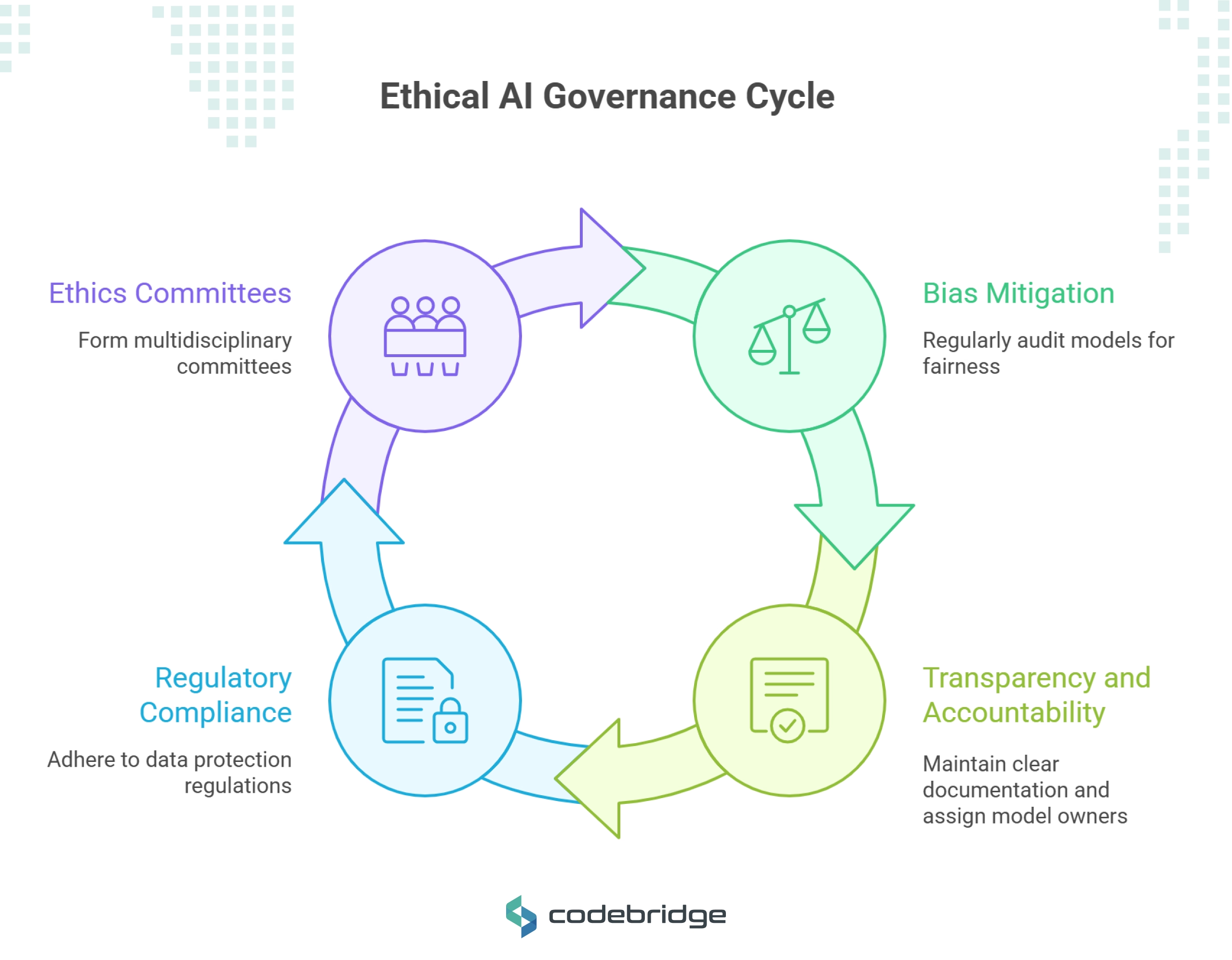
- Bias Mitigation and Fairness
Regularly audit models for demographic disparities and disparate impact. Techniques such as re-sampling, re-weighting, and adversarial debiasing help ensure equitable outcomes. Implement “explainability” tools like SHAP and LIME to surface decision pathways.
- Transparency and Accountability
Maintain clear documentation of data sources, feature engineering steps, model selection, and training parameters. Version-control models and datasets to enable full reproducibility. Assign “model owners” responsible for ongoing performance monitoring and stakeholder communications.
- Regulatory Compliance and Data Privacy
Adhere to global data-protection regulations by implementing rigorous consent management, encryption at rest and in transit, and differential privacy techniques for sensitive data. Conduct periodic third-party audits and maintain up-to-date certifications (e.g., ISO 27001).
- Ethics Committees and Governance Councils
Form multidisciplinary committees, including legal, compliance, technical, and business representatives, to review high-risk AI use cases, approve data-access requests, and adjudicate ethical dilemmas. Embed ethical checkpoints at each CODER phase.
By weaving governance and ethics into the fabric of AI initiatives, businesses safeguard brand reputation, foster user trust, and ensure the long-term viability of their AI investments.
What Lessons Do AI Business Transformation Case Studies Teach Us?
Real-world examples illuminate both best practices and pitfalls:
- Enterprise Case: Global Retailer
A Fortune 500 retailer implemented real-time personalization engines across its e-commerce platform. Using collaborative filtering and deep-learning neural networks, the company achieved a 20% uplift in online sales and a 15% reduction in cart abandonment. Key success factors included a robust customer-data platform, cross-functional sprints, and continuous A/B testing.
- Mid-Market Manufacturer: Data-Readiness Pitfalls
An industrial manufacturer embarked on a predictive-maintenance pilot only to discover critical sensor data gaps. The absence of consistent tagging conventions and missing metadata led to inaccurate failure predictions. Recovery required a dedicated data-quality task force, standardized data ingestion protocols, and phased rollouts focused on high-value assets.
- SMB Retailer: Human + AI Collaboration
A regional apparel chain deployed an AI-powered chatbot for customer service. Initial fully automated responses generated high dissatisfaction due to nuanced queries. The revised hybrid model escalated complex issues to human agents while handling routine inquiries autonomously, boosting resolution rates by 40%.
- Cross-Sector Insight: Generative AI for Content
A marketing agency integrated large language models to draft client proposals and social-media posts. While speed improved by 300%, quality variances necessitated human editing. Establishing guardrails, such as prompt templates and style guides, ensured consistency without stifling creativity.
These AI business transformation case studies underscore the importance of data readiness, human–machine collaboration, and iterative refinement.
How Will the Future AI Competitive Advantage Evolve by 2030?
Looking ahead, AI's competitive advantage will hinge on four converging trends:
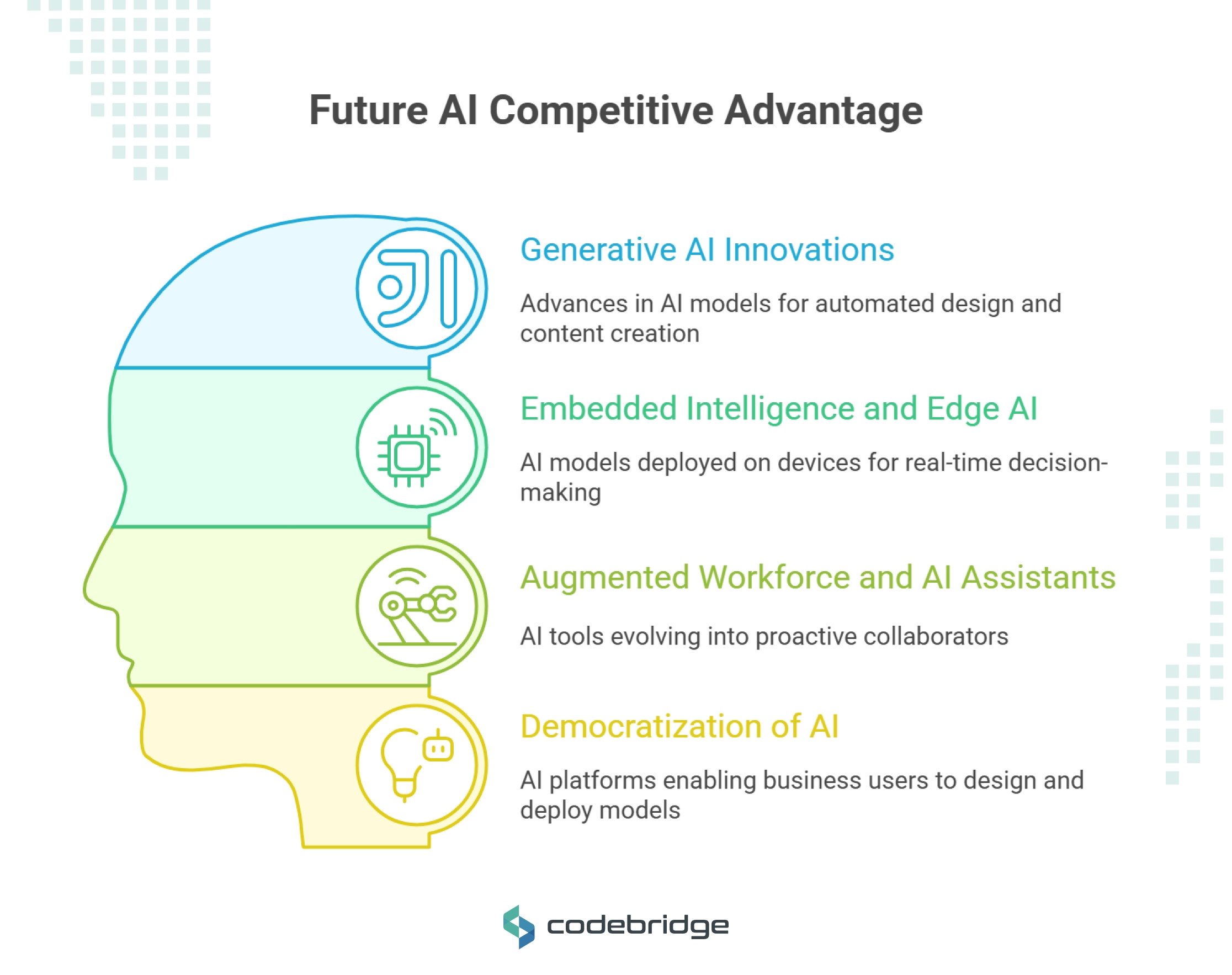
- Generative AI Innovations
Continued advances in large multimodal models will enable fully automated design, content creation, and software development pipelines. Enterprises will leverage AI co-creators to accelerate product cycles and customize offerings at scale.
- Embedded Intelligence and Edge AI
Deploying AI models directly on devices will enable real-time decision-making without latency or bandwidth constraints. Use cases include autonomous vehicles, smart manufacturing robots, and personalized in-store experiences.
- Augmented Workforce and AI Assistants
AI-augmented tools will evolve beyond task automation to become proactive collaborators, scheduling meetings, drafting reports, summarizing data insights, and even providing strategic recommendations. This “digital co-pilot” paradigm will amplify human productivity and creativity.
- Democratization of AI through Low-Code Platforms
As citizen-developer platforms mature, business users will design, test, and deploy AI models without deep technical expertise. This shift will decentralize innovation, fostering a proliferation of niche use cases and rapid experimentation.
Firms that proactively invest in these future-forward capabilities, while embedding robust governance and continuous learning cultures, will cement market leadership. Conversely, organizations that cling to legacy processes and siloed technologies risk being replaced in the race for tomorrow’s markets.
Embracing the AI impact on business is no longer optional. Organizations that integrate AI strategically unlock transformative value; those that don’t will find themselves replaced in the ever-accelerating digital economy. Partner with Codebridge to harness the power of AI and future-proof your business with scalable, intelligent solutions.
FAQ
What Is the AI Impact on Business, and Why Is It Crucial Today?
Artificial intelligence transforms operations by automating workflows, enhancing decision-making through advanced analytics, and unlocking new revenue streams. The AI impact on business drives cost reduction, efficiency gains, and competitive differentiation, making it essential for organizations aiming to remain relevant in 2026 and beyond.
How Do AI Business Benefits Improve Efficiency and Profitability?
AI business benefits include automated data processing, predictive maintenance, and personalized customer experiences. These advantages reduce labor costs by up to 30%, cut downtime by 40%, and boost average order values by 10–15%, directly contributing to higher profitability and market agility.
What Are the Core Phases of an AI Implementation Business Framework?
An effective AI implementation business framework follows CODER:
- Conceive: Define objectives and secure executive buy-in.
- Organize: Build cross-functional teams and governance.
- Develop: Pilot AI solutions with agile sprints.
- Execute: Scale successful models into production.
- Review: Monitor KPIs and refine continuously.
Which Metrics Define AI ROI Business, and How Are They Measured?
Key AI ROI business metrics include process cycle time reduction, error-rate improvements, customer satisfaction lifts (e.g., NPS), and incremental revenue from AI-driven products. Organizations track these via dashboards, cost-benefit analyses, and A/B testing to ensure transparent, measurable success.
What Are the Main AI Integration Challenges, and How Can They Be Addressed?
Common AI integration challenges are data quality issues, siloed systems, talent shortages, and legacy-system incompatibility. Solutions involve implementing unified data lakes, upskilling staff through internal programs, adopting microservices architectures, and establishing AI ethics councils for governance.
How Can Companies Leverage AI Business Value Ethically and Sustainably?
To maximize AI business value, organizations should enforce bias-mitigation techniques (e.g., re-weighting, explainability tools), ensure transparency through model documentation, comply with regulations like GDPR, and create multidisciplinary ethics committees. This governance framework safeguards trust and drives long-term adoption.
Heading 1
Heading 2
Heading 3
Heading 4
Heading 5
Heading 6
Lorem ipsum dolor sit amet, consectetur adipiscing elit, sed do eiusmod tempor incididunt ut labore et dolore magna aliqua. Ut enim ad minim veniam, quis nostrud exercitation ullamco laboris nisi ut aliquip ex ea commodo consequat. Duis aute irure dolor in reprehenderit in voluptate velit esse cillum dolore eu fugiat nulla pariatur.
Block quote
Ordered list
- Item 1
- Item 2
- Item 3
Unordered list
- Item A
- Item B
- Item C
Bold text
Emphasis
Superscript
Subscript







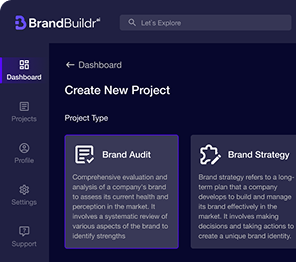











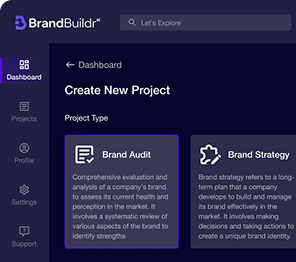
.avif)



.avif)

.avif)



